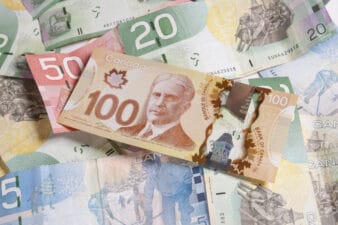The Big Six banks in Canada have collectively amassed $40.5 billion in excess common equity tier 1 (CET1) capital after Q2 fiscal 2021 (quarter ended April 30, 2021). None of them had to use their bloated provision for credit losses (PCLs) because the anticipated rise in delinquencies didn’t happen.
However, the lenders were able to resolve their pleasant problem of deploying the stashes of cash recently. All the banks announced dividend increases when they presented their Q4 and full-year fiscal 2021 earnings results. The Office of the Superintendent of Financial Institutions (OSFI) lifted the ban on dividend increases and share buybacks in early November 2021.
Perfect timing
Income investors should delight in the dividend ‘tsunami’ or bonanza. Apart from heightening interest in bank stocks, the timing is perfect. Inflation is rising, and dividend investing is one of the tools Canadians can use to cope with it or lessen the impact on purchasing power.
The dividend increases of the Royal Bank of Canada (TSX:RY), Toronto Dominion Bank (TXS:TD)(NYSE:TD), Bank of Nova Scotia (TSX:BNS)(NYSE:BNS), and Canadian Imperial Bank of Commerce (TSX:CM)(NYSE:CM) are not more than 11%. Only Bank of Montreal (25%) and the National Bank of Canada (23%) announced more than 20% hikes.
Before the announcements, BNS and CIBC paid the highest yield. When the hikes take effect in Q1 2021, their dividends would still be higher than the rest. Yield-hungry investors are likely to gravitate towards them and make either one their core holdings next year.
More earnings power in 2022
As of December 9, 2021, BNS shares traded the lowest among the Big Six banks. At $85.80 per share (+30.75% year-to-date), the dividend yield is a hefty 4.68%. Canada’s third-largest lender has a mean dividend track record. The first dividend payment date by this $103.4 billion bank was July 1, 1833.
Like most dividend-paying companies and under its current dividend policy, the payout of BNS is quarterly. As earnings grow, management consistently increases the payouts. It has done so in 43 of the last 45 years. Furthermore, the total return in 49 years is 195,925.2% (16.72% CAGR).
BNS exceeded its medium-term financial targets in fiscal 2021 (year ended October 31, 2021). After reporting a 45.3% increase in net income to $9.95 billion versus fiscal 2020, its President and CEO, Brian Porter, said the bank is well-positioned to achieve its full earnings power in the next fiscal year.
Strengthening key fundamentals
CIBC’s earnings results in fiscal 2021 were more than impressive. Canada’s fifth-largest bank reported $6.4 billion in net income, a 68.4% increase versus fiscal 2020. Its President and CEO, Victor Dodig, cites the growth across all the bank’s strategic business units as the reason for the strong financial performance.
The $63.16 billion bank isn’t resting on its laurels. Management’s immediate goals are to expand CIBC’s platform and capabilities in the U.S. and accelerate the growth of its Canadian consumer franchise.
Investors are up 34.62% year-to-date and partaking in the 4.53% dividend regarding stock performance. Based on market analysts’ forecasts, the current share price of $141.79 can climb by at least 16.6% to $165.39 in 12 months.
Decades-long income
Whether you pick BNS or CIBC as your anchor in 2022, you won’t be selling either anymore. Both blue-chip stocks should deliver uninterrupted income streams for decades.








